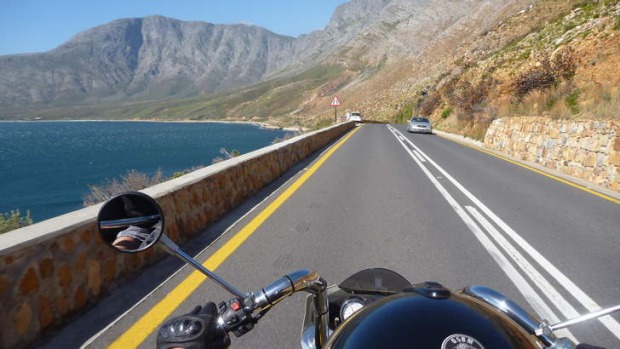
A coastal trike tour raises eyebrows and offers great sights, writes Rob McFarland.
Most guests staying at Cape Town's five-star Cape Grace Hotel arrive and depart by chauffeur-driven limousine.
So you can imagine the eyebrows raised when I'm picked up by a leather-clad man-mountain on a mustard-coloured trike. I don my helmet, gingerly climb aboard and sheepishly wave goodbye to a bemused crowd of onlookers. There'll be disapproving murmurs during afternoon tea for sure.
At the helm of this outlandish machine is Willem Mulder. A keen biker, he imported the custom-built trike from Boom Trikes in Germany and started Cape Trike Tours. Today, we're off to Hermanus, a historic fishing village 115 kilometres southeast of Cape Town, but he also offers tours to Cape Point, the West Coast and Stellenbosch.
After an exhilarating 45-minute blast along the N2 motorway, we reach Sir Lowry's Pass, where the road snakes up and over the Hottentots-Holland mountain range. As will happen repeatedly today, the focus of attention when we stop at the lookout is not the sweeping panorama; it's our mode of transport. For a while I feel like a celebrity, until I realise everyone is really only interested in the trike and not the helmet-clad tourist perched on the back.
After a brief refreshment stop at the elegant 18th-century Houw Hoek Inn, we continue towards the coast through an undulating landscape of wheat fields and orchards. Once a busy fishing village and whaling centre, Hermanus is now a buzzy seaside town of holiday homes, shops and outdoor cafes.
We have lunch in Bientang's Cave, a popular seafood restaurant carved into the cliff, and enjoy mussels washed down with a glass of sauvignon blanc (at least I do, Willem sensibly orders a Coke).
In addition to a craft market and whaling museum, Hermanus boasts the curious claim of having a train station but no tracks. Locals felt too many visitors would spoil the town's sleepy appeal and successfully stopped the line being built. After dispersing another group of snap-happy tourists, we start the return journey via Clarence Drive, a spectacular coastal route that squirms its way between the towering Kogelberg Mountains and the pounding surf of False Bay.
To my untrained eye, this scrub-covered landscape looks barren and unfertile but it transpires we're passing through the Kogelberg Biosphere, a UNESCO registered reserve of extraordinary diversity.
This 100,000 hectare region is home to more than 1880 species of plants, 77 of which are endemic, meaning they occur nowhere else in the world. By comparison there are only 22 endemic species in the whole of the United Kingdom.
We make one last stop at the Drummond Arms, a popular biker pub in the tiny hamlet of Rooi Els, before rejoining the motorway for the final charge back into Cape Town. To the credit of the hotel staff, no one bats an eyelid when I stumble in wild-eyed and helmet-haired raving about endemic species and biospheres.
TRIP NOTES
GETTING THERE
Qantas flies to Cape Town via Johannesburg, phone 13 13 13, see qantas.com.au.
STAYING THERE
Ideally located on the V&A Waterfront, the Cape Grace boutique luxury hotel stylishly combines Philippe Starck modernism with Cape Dutch antiquities, see capegrace.com.
TOURING THERE
Cape Trike's Hermanus tour lasts eight hours and costs ZAR2800 ($278) for two people, see capetriketours.co.za.
MORE INFORMATION
southafrica.net.